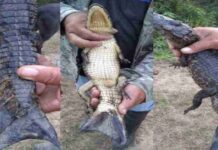In a surprising turn of events, actor Will Smith played a crucial role in the accidental discovery of the largest anaconda species ever recorded. The discovery occurred while he was filming for an upcoming National Geographic television series titled Pole to Pole with Will Smith. While the team was initially documenting Amazon wildlife, they ended up capturing footage of what could be the largest anaconda ever discovered—an encounter that could rewrite records in the field of herpetology.
While filming in the Amazon River region for the show, Smith joined a scientific team led by Professor Bryan Fry from the University of Queensland. Their goal was to explore the biodiversity of the Amazon, particularly its snake population. Local hunters in the area had reported sightings of extremely large anacondas, some over 20 feet in length. Curious to verify these claims, the team ventured deeper into the jungle with the help of local guides familiar with the terrain.
Initially, they captured several large anacondas on camera. However, during their journey through the shallow, murky waters of the Amazon, the crew encountered an anaconda that dwarfed all previous specimens. Measuring approximately 20.7 feet (6.4 meters) in length, this anaconda is now being considered the largest ever recorded on Earth.
The Largest Anaconda Found While Filming with Will Smith
It’s hard to believe that such a significant biological discovery would occur while filming a television series with a Hollywood celebrity. Yet this is precisely what happened. The team was exploring the remote Bameno region of the Baihuaeri Waorani Territory—an area so isolated that it rarely sees outsiders.
While paddling through rivers in this remote area, the team captured multiple anacondas on video. However, the standout moment came when they encountered the massive snake later identified as a new species: the northern green anaconda (Eunectes akayima).
This new species adds to the already known green anacondas of the Amazon and shows just how much of the rainforest remains unexplored. According to local reports, there are still larger snakes—up to 24 feet in length—believed to be living in these untouched regions.
The discovery of the northern green anaconda serves as a powerful reminder of the mysteries that the natural world still holds. It emphasizes the importance of continued exploration, scientific research, and the integration of indigenous knowledge in understanding and preserving our planet’s biodiversity.
As viewers await the release of Pole to Pole with Will Smith, this extraordinary finding adds a compelling chapter to the narrative, showcasing the wonders that lie within the uncharted territories of the Amazon.
Indigenous Knowledge Played a Vital Role
The role of local indigenous communities, particularly the Waorani people, was critical in this discovery. Their knowledge of the land, wildlife, and water routes allowed the scientists to locate areas where massive anacondas had previously been spotted. Without this collaboration, such a discovery might never have been made.
The successful identification of the northern green anaconda was not just a scientific feat but a cultural collaboration. Indigenous hunters and trackers often navigate these dense forests and shallow riverbanks. They know the signs, behaviors, and habitats of wildlife better than most outsiders. The Waorani were instrumental in guiding the crew to the exact locations where the giant anacondas were known to dwell.
In fact, local residents believe that even larger specimens exist—some as long as 24 feet. These claims, though unverified, are now being taken seriously by scientists eager to return and study the region further.
The Amazon: A Land Full of Secrets
The Amazon rainforest remains one of the most mysterious and unexplored ecosystems on Earth. With its vast, dense foliage and challenging terrain, many areas have never been scientifically documented. Thousands of species, both plant and animal, remain undiscovered.
This anaconda discovery reaffirms the belief that the Amazon still hides many natural wonders. It also emphasizes the need for conservation, as many of these species live in delicate ecosystems that are increasingly threatened by deforestation, climate change, and human activity.
Such discoveries not only excite the scientific community but also attract further research. The new anaconda species brings renewed attention to the biodiversity of the region and strengthens the argument for preserving these fragile environments.
A New Chapter in Anaconda Research
The discovery of the Eunectes akayima, or northern green anaconda, has opened up a new chapter in the study of giant snakes. Researchers now know that there are genetically distinct populations of anacondas that were previously grouped under a single species.The team paddled down river systems in canoes, capturing multiple specimens of the massive snake, including one that measured a stunning 20.7 feet.
This finding may motivate scientists to revisit other anaconda populations and re-evaluate existing classifications. With the help of advanced DNA analysis and indigenous knowledge, there could be more surprises waiting in the rainforest. During their 10-day expedition, the scientists were guided by indigenous hunters, who led them through the jungle to find the giant snakes that locals had long believed to be the largest in existence.
This revelation will likely inspire other research teams to explore the Amazon more deeply. The possibility that 24-foot-long anacondas still roam the dense jungle is no longer dismissed as myth or exaggeration—it is now a plausible scientific question.
Conclusion: A Giant Leap for Science, Guided by a Star
This remarkable discovery proves that science can happen anywhere—even on a television set. Thanks to Will Smith’s expedition and the dedicated team of scientists, the world has now been introduced to the largest anaconda species ever discovered.
It’s a reminder that the natural world still holds incredible secrets and that collaboration between science and indigenous knowledge is key to uncovering them. With much of the Amazon still unexplored, there’s no telling what other monumental discoveries lie just around the riverbend.
The episode featuring this discovery is set to air as part of the upcoming Pole to Pole with Will Smith series on National Geographic. For viewers and scientists alike, it promises a rare and thrilling glimpse into the untouched wilderness of the Amazon—and the giant snake that now holds a world record.







